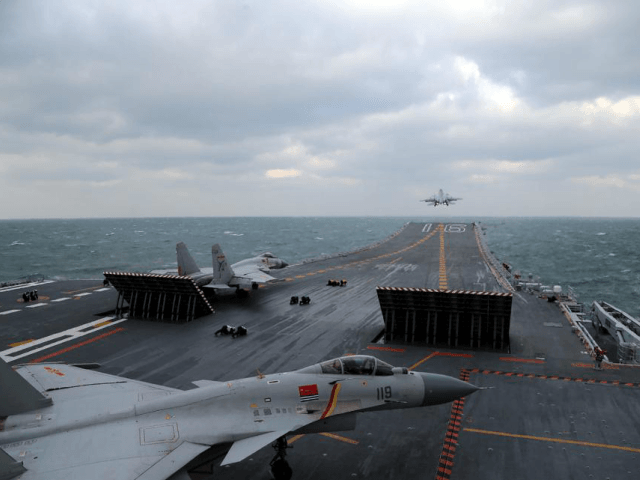The Chinese People’s Liberation Army (PLA) conducted air force exercises around Taiwan this weekend, as well as near South Korea and Japan, releasing a video of the drills.
The exercises follow a threat of senior Chinese diplomat Li Kexin that China will use military force against Taiwan if American Navy ships make a port call to the island.
The Taipei Times reports that, according to PLA officials, “Fighter and bomber aircraft flew through the Tsushima Strait that separates South Korea from Japan and into international waters in the Sea of Japan, adding that the Sea of Japan is not Japan’s, and the drills were lawful and reasonable.” Japan and South Korea both responded angrily. Seoul’s government told reporters that it had used a hotline to warn China to cease violating its airspace and scrambled jets in response.
The PLA also sent its air force “through the Bashi Channel between Taiwan and the Philippines, and then returning to base through the Miyako Strait, to Taiwan’s north and near Japan’s southern islands.” The South China Morning Post notes that the Chinese government also recently released video of “encirclement patrols” around Taiwan by its H-6K bomber and Su-30 fighter jets.
The Taiwanese government responded to the drills by decrying “irresponsible” military behavior. “Such actions are irresponsible and they are not welcomed by the international community,” Presidential Office spokesman Alex Huang said on Sunday.
Experts tell the South China Morning Post they fear China may be “gearing up to take over the self-ruled island by force.” The Chinese state media outlet People’s Daily, in turn, cited government officials who insisted the drills were necessary to protect Taiwan, which China considers a province of the People’s Republic.
“Multiple bombers and reconnaissance planes have flown routes that circled the island of Taiwan, further improving their ability to protect national sovereignty and territorial integrity,” PLA spokesman Senior Colonel Shen Jinke is quoted as saying in the People’s Daily.
The Daily noted that the PLA had conducted “routine” exercises around Taiwan nine times since August.
The exercises occurred shortly before the United States published its 2017 National Security Strategy (NSS), a comprehensive blueprint for how the Trump administration will approach international affairs. The NSS affirms solidarity with the Taiwanese people and further financial and political cooperation.
Chinese Foreign Ministry spokeswoman Hua Chunying responded to the NSS by reaffirming that China does not acknowledge Taiwanese sovereignty. “We urge the U.S. side to abide by the one-China principle and the stipulations in the three China-U.S. joint communiqués and properly handle the Taiwan-related issues, thus avoiding disturbing the overall picture of China-U.S. cooperation,” she said.
Last week, Chinese embassy minister Li Kexin went a step further, warning that a U.S. military presence in Taiwan would trigger a Chinese military response.
“The day that a U.S. Navy vessel arrives in Kaohsiung is the day that our People’s Liberation Army unifies Taiwan with military force,” he stated, referring to a port city in southwestern Taiwan.
“The Chinese mainland resolutely opposes any exchanges between militaries or government officials of the United States and Taiwan,” a spokesman for China’s Taiwan Affairs Office stated later in the week.
In addition to these warnings and drills, the Chinese government has heavily militarized artificial islands it illegally constructed in the South China Sea. A report by the Asia Maritime Transparency Initiative (AMTI) at the Center for Strategic and International Studies (CSIS) released last week found evidence of infrastructure that could support “fully-functioning air and naval bases on the larger outposts” in territory belonging to the Philippines and Vietnam, and a hop away from Taiwan.

COMMENTS
Please let us know if you're having issues with commenting.